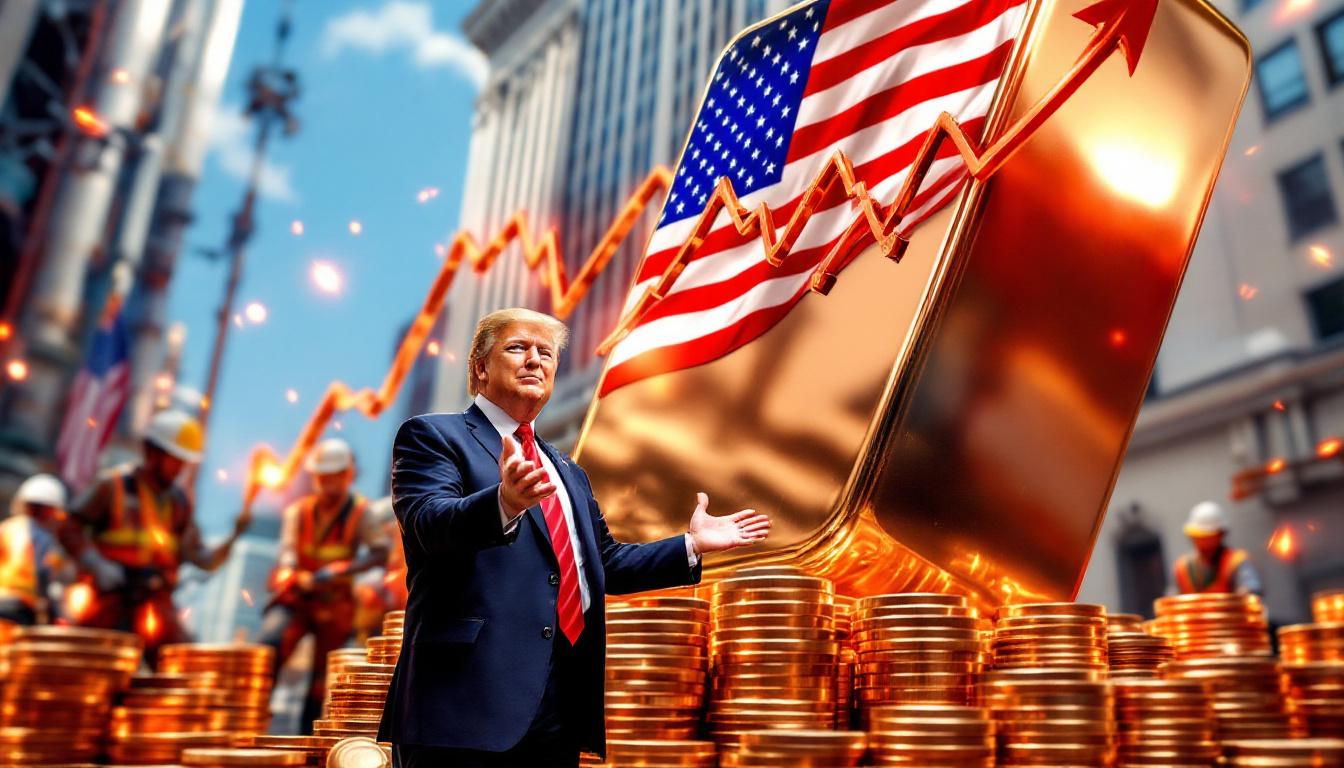Trump's Tariff Policy: Impact on Global Trade and Markets
The recent shifts in U.S. trade policy under the Trump administration have catalyzed significant disruptions in global markets, supply chains, and international relations. Central to this disruption is the implementation of tariffs targeting key trading partners, particularly China, with proposed rates initially as high as 40% before settling at 10–20% for many nations. The administration's "America First" strategy prioritizes reducing trade deficits and repatriating manufacturing, but its abrupt rollout triggered historic market volatility, including a near "Liz Truss moment" in U.S. bond markets. While equities rebounded sharply following policy clarifications—such as the S&P 500's 9.5% single-day surge—underlying structural risks persist, including bond market fragility, supply chain dislocations, and geopolitical tensions. This report analyzes the multifaceted impacts of Trump and US tariff policy, from capital flow realignments to emerging market opportunities, while contextualizing their long-term implications for global economic stability.
Trump's Key Tariff Policies
The "America First" Trade Strategy
The Trump administration's trade agenda centers on revitalizing domestic manufacturing through protective tariffs, aiming to reverse decades of offshoring. Treasury Secretary Bessent framed this as prioritizing "Main Street over Wall Street," emphasizing job creation and industrial self-sufficiency. However, the initial blanket tariff proposal destabilized markets, with bond yields spiking to 4.4% as investors feared inflationary pressures and supply chain bottlenecks. The subsequent revision to 10–20% tariffs eased immediate concerns but failed to address systemic uncertainties for corporations, exemplified by a canceled $300 million U.S. factory project due to unclear import costs for Chinese industrial equipment.
Strategic Targeting of China
China remains the primary focus, with tariffs designed to curb its dominance in critical sectors like electronics and raw materials. This approach risks accelerating decoupling, as Chinese policymakers face a dilemma: devalue the yuan to offset tariffs (hurting commodities) or implement fiscal stimulus (boosting demand). Historical precedents, such as the Plaza Accord's 50% dollar devaluation, suggest coordinated currency adjustments could emerge, though Trump's energy policies and adversarial stance complicate bilateral negotiations.
Global Market Reactions
Initial Panic and Rebound Dynamics
The tariff announcements triggered the largest single-day hedge fund buying spree on record, with Morgan Stanley reporting a 10% net exposure increase. Retail investors capitalized on lows, while institutions bought highs, reflecting divergent risk appetites. The NASDAQ's 12% rebound echoed the January 2001 recovery, which preceded a 50% drawdown within a year—a cautionary tale for current optimism. Bond markets, however, failed to act as safe havens, signaling deeper concerns about U.S. fiscal sustainability.
European Capital Repatriation
European investors have withdrawn approximately €10 trillion from U.S. markets since 2020, with private banking clients reducing unhedged equity exposures from 70% to rebalance portfolios amid dollar volatility. Germany's €1 trillion fiscal package, including €500 billion for defense, underscores a broader shift toward regional self-reliance, mirroring U.S. protectionism. This repatriation has strengthened the euro, contrasting with the dollar's vulnerability to managed devaluation scenarios.
Impact on Global Trade
Supply Chain Disruptions
Uncertainty over tariff longevity has stalled corporate investments, particularly in industries requiring 5–8-year planning horizons for factory construction. For example, reliance on Chinese raw materials has forced manufacturers to delay projects, fearing cost escalations. Policy inconsistency between administrations exacerbates this, as firms weigh the risk of future reversals under Democratic leadership.
Geopolitical Realignments
Damaged U.S.-China relations may prove irreversible, pushing Beijing toward alternatives like the Regional Comprehensive Economic Partnership (RCEP). Meanwhile, Europe and Japan have leveraged tariff exemptions to negotiate favorable terms, albeit amid concerns over retaliatory measures. The European Union's accelerated de-globalization, marked by reshoring subsidies and local content rules, reflects a global trend toward bifurcated trade blocs.
Shifts in Global Capital Flows
Decline of American Exceptionalism
The dollar's reserve currency status faces unprecedented strain, with foreign holdings of U.S. debt declining as central banks diversify into euros and yuan. European pension funds, burned by 15% underperformance from currency-unhedged U.S. equities, are reallocating to domestic infrastructure and green energy projects. This mirrors Germany's industrial revival, funded by its first major fiscal expansion since reunification.
Emerging Market Opportunities
Brazil emerges as a standout, offering 8–9% dividend yields and exposure to commodities like iron ore and soybeans, which hedge against dollar weakness. With interest rates at 15%, falling inflation could spur a consumer boom post-Lula, attracting foreign inflows currently absent despite 17% YTD equity gains. Argentina's Milei reforms, though early-stage, suggest latent potential in resource-rich South American markets.
Gold and Commodities as Hedges
Gold's Safe Haven Role
Gold market analysis shows it has outperformed equities and bonds, signaling distrust in traditional hedges. Its divergence from Treasury movements suggests markets anticipate prolonged dollar weakness, akin to the 1985 Plaza Accord. Central bank gold purchases, notably by China and India, reinforce this trend, with bullion serving as insurance against currency devaluation.
Commodity Market Outlook
Ivan Glazenberg's $300 million Glencore investment—his first since 2015—highlights confidence in a post-turbulence commodities surge. Copper and lithium are poised to benefit from green energy demand, though China's stimulus/devaluation choice remains pivotal. Trump's commodity impact would vary depending on the response, as a fiscal stimulus would boost industrial metals, while yuan devaluation could depress prices short-term.
The Long-Term Economic Consequences
Manufacturing Revival Challenges
Despite Trump and US tariff policy goals of bringing manufacturing back to the United States, the reality presents significant hurdles. Building new factories typically requires 5-8 years from planning to production, creating a substantial lag between policy implementation and economic outcomes. Additionally, many U.S. manufacturers remain dependent on Chinese components and raw materials, complicating immediate reshoring efforts.
Inflationary Pressures
Economists project that a full implementation of Trump's tariff policy could add 1-2 percentage points to U.S. inflation rates, according to White House fact sheets. This comes at a critical time when the Federal Reserve has been working to control inflation without triggering a recession. The additional cost burden on imported goods would likely be passed to consumers, potentially dampening purchasing power and economic growth.
FAQ About Trump's Tariff Policy
Is the tariff policy likely to achieve its stated goals?
While the goal of rebuilding American manufacturing has merit, implementation challenges include the time required to build new factories (5-8 years), uncertainty about policy continuity between administrations, and the reality that many industrial components are still imported from China. Success depends largely on companies' willingness to make long-term investments despite policy uncertainty.
How might China respond to increased tariffs?
China has two primary options: currency devaluation (negative for commodities) or fiscal stimulus (positive for commodities). Their choice will significantly impact global commodities insights and prices. Recent history suggests China may employ a combination of targeted stimulus and strategic devaluation while seeking alternative export markets.
What lessons can be learned from the market's reaction?
The bond market's failure to act as a safe haven during equity market turbulence suggests deeper concerns about U.S. fiscal policy. The dramatic market rebounds following clarification highlight the importance of clear communication in policy implementation. These market dynamics insights demonstrate how quickly sentiment can shift based on policy rhetoric versus actual implementation details.
How should investors position themselves in this environment?
A balanced approach is recommended, with exposure to potential beneficiaries of dollar weakness (commodities, emerging markets), while maintaining flexibility given the uncertain policy environment. Gold has demonstrated its traditional safe haven characteristics during this period of heightened volatility, making it an attractive component of diversified portfolios.
What is the "trade after the trade"?
This refers to positioning for the eventual market environment after current volatility subsides, likely characterized by dollar weakness, commodity strength, and outperformance of certain emerging markets. As reported by CNBC, investors who look beyond immediate market reactions may find opportunities in Brazilian equities, gold, and industrial metals as longer-term beneficiaries of the shifting trade landscape.
Conclusion
The Trump tariff regime has exposed vulnerabilities in hyper-globalized supply chains while reshaping capital flows toward regional blocs. While the S&P's rebound suggests market resilience, structural risks—from bond market fragility to manufacturing inertia—persist. Policymakers must balance protectionism with multilateral coordination to avoid a 1930s-style trade collapse. For investors, Brazilian equities, gold, and select commodities offer hedges against dollar decline, though geopolitical volatility necessitates agile positioning.
Ready to Catch the Next Major Mining Discovery?
Don't miss out on significant ASX mineral discoveries that could transform your portfolio. Explore Discovery Alert's dedicated discoveries page to see how our proprietary Discovery IQ model helps investors identify actionable opportunities ahead of the broader market.




